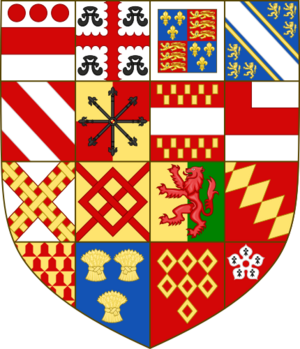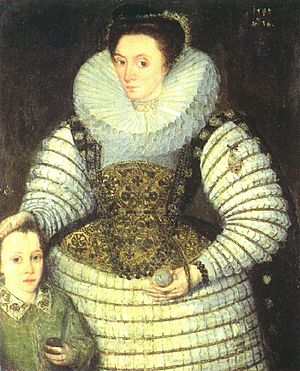Robert Devereux, 2nd Earl of Essex facts for kids
Quick facts for kids
Robert Devereux
|
|
|---|---|
| Earl of Essex | |
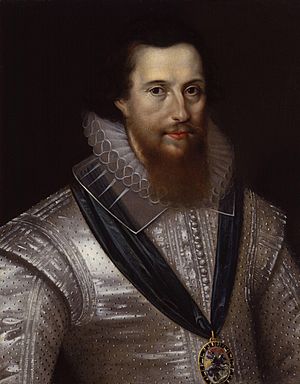
The 2nd Earl of Essex, by Marcus Gheeraerts the Younger
|
|
| Tenure | 1576–1601 |
| Predecessor | Walter Devereux, 1st Earl of Essex |
| Successor | Robert Devereux, 3rd Earl of Essex |
| Known for | Favourite of Elizabeth I |
| Born | 10 November 1565 Netherwood near Bromyard, Herefordshire, Kingdom of England |
| Died | 25 February 1601 (aged 35) Liberties of the Tower, London, Kingdom of England |
| Cause of death | Execution by beheading |
| Buried | Church of St Peter ad Vincula, London |
| Nationality | English |
| Residence | Essex House, London Merevale Hall, Warwickshire |
| Wars and battles | Dutch revolt Spanish Armada English Armada Capture of Cádiz Azores expedition, 1597 Irish Nine Years' War |
| Offices | Master of the Horse Privy Councillor Earl Marshal Master-General of the Ordnance Lord Lieutenant of Ireland |
| Spouse(s) | |
| Issue | Robert Devereux, 3rd Earl of Essex Lady Dorothy Devereux Frances Seymour, Duchess of Somerset Sir Walter Devereux (illegitimate) |
| Parents | Walter Devereux, 1st Earl of Essex Lettice Knollys |
| Signature |  |
Robert Devereux, 2nd Earl of Essex (born 10 November 1565 – died 25 February 1601) was an English nobleman. He was a special friend, or "favourite," of Queen Elizabeth I. Robert Devereux was a brave general who wanted to gain more power.
He was put under house arrest after a difficult military mission in Ireland in 1599. In 1601, he tried to lead a rebellion against Queen Elizabeth I's government. He was found guilty of treason and was executed.
Contents
Robert Devereux's Early Life
Robert Devereux was born on November 10, 1565, in Netherwood, Herefordshire. His parents were Walter Devereux, 1st Earl of Essex and Lettice Knollys. His mother's great-grandmother was Mary Boleyn. Mary Boleyn was the sister of Anne Boleyn, who was Queen Elizabeth I's mother. This made Robert Devereux a distant cousin of the Queen.
He grew up on his father's lands in Staffordshire and Wales. He studied at Trinity College, Cambridge, and earned a Master of Arts degree in 1581.
In 1578, Robert's mother married Robert Dudley, Earl of Leicester. Dudley was also a close friend of Queen Elizabeth I.
Marriage and Family
In 1590, Robert Devereux married Frances Walsingham. She was the daughter of Sir Francis Walsingham and the widow of Sir Philip Sidney. Queen Elizabeth I did not approve of this marriage. Robert and Frances had several children together.
Robert Devereux's Career at Court
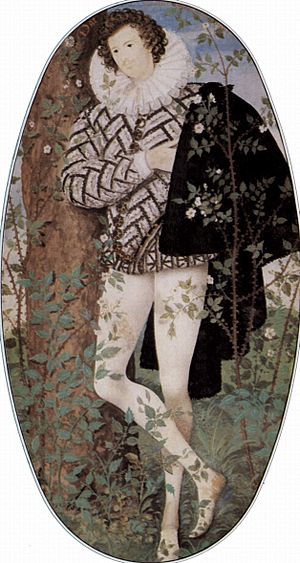
Robert Devereux first came to the Queen's court in 1584. By 1587, he had become one of Queen Elizabeth's favourites. She liked his clever mind and his way with words. She also enjoyed his skills in courtly games and shows.
In 1587, he became the Master of the Horse. This was an important role in the Queen's household. After Robert Dudley died in 1588, the Queen gave Essex the right to collect taxes on sweet wines. This gave him a lot of money. In 1593, he became a member of her Privy Council, a group of trusted advisors.
Robert Devereux's friend, Francis Bacon, warned him. Bacon told him not to upset the Queen by trying to gain too much power. He also advised him not to underestimate her ability to rule.
However, Essex did not always listen. He sometimes acted disrespectfully towards the Queen. He also showed little regard for her main secretary, Robert Cecil. Once, during a heated discussion about Ireland, the Queen reportedly hit Essex on the ear. This made him so angry that he almost drew his sword on her.
Military Campaigns
In 1589, Essex joined Francis Drake's fleet that sailed to Spain. This was an attempt to follow up on England's victory over the Spanish Armada. However, the Queen had told him not to go. The English fleet lost many ships and men.
In 1591, he led a force to help King Henry IV of France. In 1596, he showed great bravery by helping to capture the city of Cádiz in Spain.
In 1597, he went on an expedition to the Azores islands. His second-in-command was Walter Raleigh. Essex disobeyed the Queen's orders. He chased the Spanish treasure ships instead of first defeating the Spanish battle fleet.
Later that year, a Spanish fleet appeared off the English coast. The English fleet was far away, leaving the coast unprotected. This caused panic. This event further damaged the relationship between the Queen and Essex. Luckily, a storm scattered the Spanish fleet.
Robert Devereux in Ireland
Essex's biggest challenge was when he became Lord Lieutenant of Ireland in 1599. This was during the Nine Years' War (1595–1603). No English commander had been able to defeat the Irish leaders, especially Hugh O'Neill, 3rd Earl of Tyrone.
Essex led the largest army ever sent to Ireland, with 16,000 soldiers. He was ordered to end the rebellion. People in London cheered him as he left, expecting a quick victory.
However, Essex did not go straight to fight O'Neill in Ulster as planned. Instead, he led his army into southern Ireland. There, he fought battles that did not achieve much. He spent his money and spread his army out into small forts. Meanwhile, the Irish won important battles elsewhere.
Instead of fighting O'Neill, Essex made a truce with him. Some people thought this truce was shameful for England. The Queen was very unhappy. She told Essex that if she wanted to give up Ireland, she would not have needed to send him there.
Essex also gave out many knighthoods to his officers. The Queen usually gave out these honours very carefully. The rebels in Ireland even joked that "he never drew sword but to make knights."
Robert Devereux's Trial and Rebellion
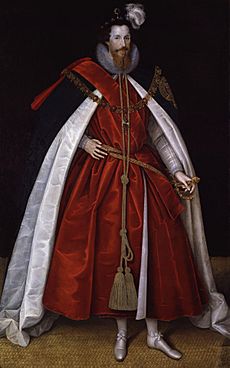
Essex returned to England from Ireland on September 28, 1599. The Queen had strictly forbidden him to return. She was very surprised when he appeared in her bedroom at Nonsuch Palace before she was ready.
The Queen confined him to his rooms. She said that "an unruly beast must be stopped of his provender," meaning he needed to be controlled. Essex was questioned by the Privy Council for five hours. They decided his truce with O'Neill was wrong and that leaving Ireland was like deserting his duty. He was put under house arrest.
Essex blamed Robert Cecil and Walter Raleigh for the Queen's anger. Raleigh advised Cecil to make sure Essex did not get his power back.
On June 5, 1600, Essex was tried by a group of 18 men. He had to listen to the charges against him while kneeling. Essex was found guilty. He lost his public offices and remained mostly confined.
The Essex Rebellion
In August, Essex was granted more freedom. However, the Queen did not renew his valuable sweet wines monopoly. This meant he lost his main source of income. His situation became very difficult. He changed from being sad and sorry to being angry and rebellious.
In early 1601, he began to strengthen his home, Essex House, and gathered his supporters. On February 8, he marched out of Essex House with a group of nobles and gentlemen. He entered the city of London, hoping to force a meeting with the Queen.
However, Robert Cecil immediately declared him a traitor. Essex's men were stopped by Crown forces. Essex and his men returned to Essex House. After Crown forces surrounded his home, Essex surrendered.
Treason Trial and Death
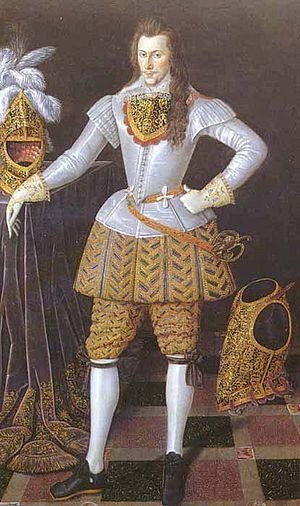
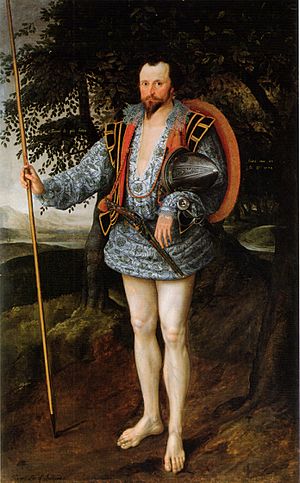
On February 19, 1601, Essex was tried for treason by other nobles. He was found guilty.
On February 25, 1601, Robert Devereux was executed by beheading at Tower Green. He was the last person to be beheaded at the Tower of London. It is said that it took three strikes by the executioner to complete the execution.
Before his execution, Essex accused his sister, Penelope, Lady Rich, of being part of his plans. However, the Queen, who wanted to be as kind as possible, ignored this charge.
A few days before the execution, Captain Thomas Lee was caught near the Queen's chambers. He had planned to hold her until she signed a paper to release Essex. Captain Lee, who had served with Essex in Ireland, was tried and executed the next day.
Because Essex was found guilty of treason, his title of Earl was taken away. His son did not inherit it right away. However, after Queen Elizabeth's death, King James I of England gave the earldom back to Essex's son, Robert Devereux, 3rd Earl of Essex.
The Essex Ring Story
There is a famous romantic story about a ring that Queen Elizabeth gave to Essex. The story says that Elizabeth gave Essex a ring after his success in Cádiz. She told him to send it back to her if he was ever in trouble.
After his trial, Essex supposedly tried to send the ring to Elizabeth through the Countess of Nottingham. But the Countess kept the ring because her husband was an enemy of Essex. Because the Queen did not receive the ring, Essex was executed.
The story continues that on her deathbed, the Countess confessed this to Elizabeth. The Queen was very angry and said, "May God forgive you, Madam, but I never can."
Some historians believe this story is a myth. There are no records of it from the time it supposedly happened. Many historians consider it a made-up tale.
Images for kids
See also
 In Spanish: Robert Devereux, II conde de Essex para niños
In Spanish: Robert Devereux, II conde de Essex para niños


